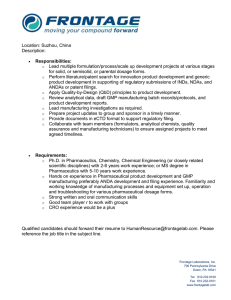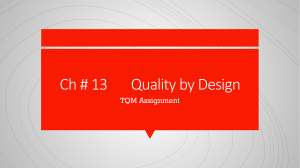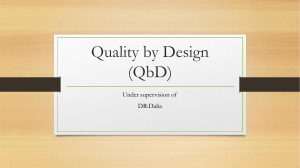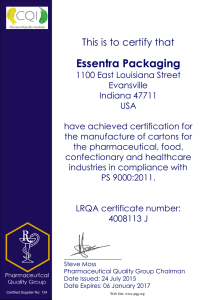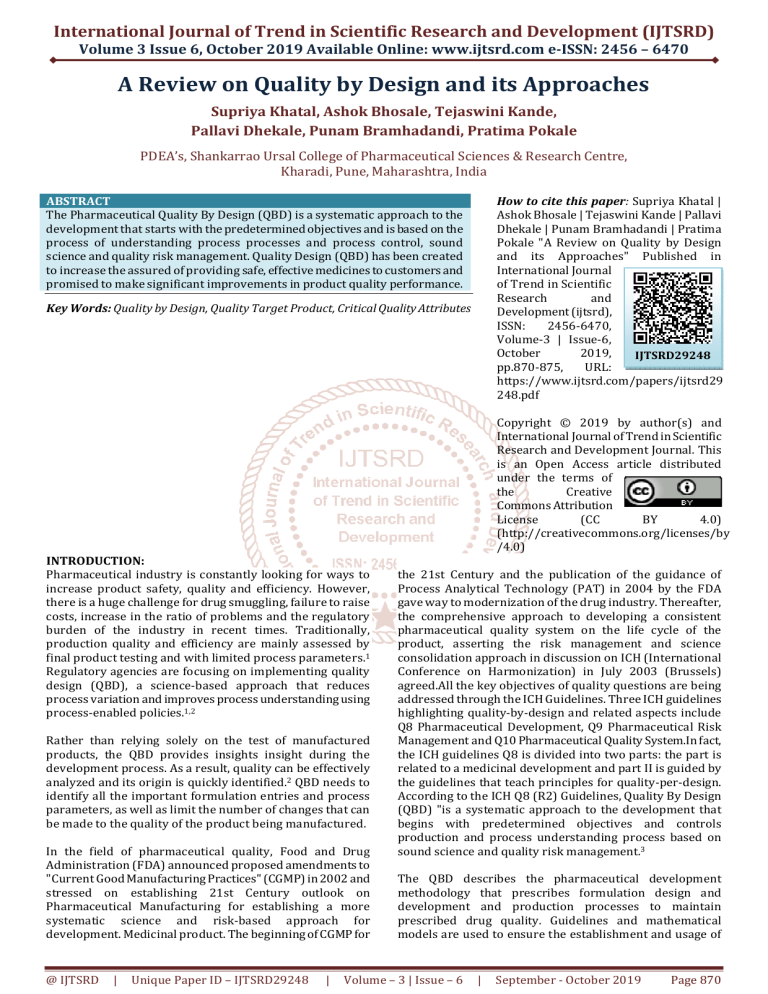
International Journal of Trend in Scientific Research and Development (IJTSRD) Volume 3 Issue 6, October 2019 Available Online: www.ijtsrd.com e-ISSN: 2456 – 6470 A Review on Quality by Design and its Approaches Supriya Khatal, Ashok Bhosale, Tejaswini Kande, Pallavi Dhekale, Punam Bramhadandi, Pratima Pokale PDEA’s, Shankarrao Ursal College of Pharmaceutical Sciences & Research Centre, Kharadi, Pune, Maharashtra, India ABSTRACT The Pharmaceutical Quality By Design (QBD) is a systematic approach to the development that starts with the predetermined objectives and is based on the process of understanding process processes and process control, sound science and quality risk management. Quality Design (QBD) has been created to increase the assured of providing safe, effective medicines to customers and promised to make significant improvements in product quality performance. How to cite this paper: Supriya Khatal | Ashok Bhosale | Tejaswini Kande | Pallavi Dhekale | Punam Bramhadandi | Pratima Pokale "A Review on Quality by Design and its Approaches" Published in International Journal of Trend in Scientific Research and Development (ijtsrd), ISSN: 2456-6470, Volume-3 | Issue-6, October 2019, IJTSRD29248 pp.870-875, URL: https://www.ijtsrd.com/papers/ijtsrd29 248.pdf Key Words: Quality by Design, Quality Target Product, Critical Quality Attributes Copyright © 2019 by author(s) and International Journal of Trend in Scientific Research and Development Journal. This is an Open Access article distributed under the terms of the Creative Commons Attribution License (CC BY 4.0) (http://creativecommons.org/licenses/by /4.0) INTRODUCTION: Pharmaceutical industry is constantly looking for ways to increase product safety, quality and efficiency. However, there is a huge challenge for drug smuggling, failure to raise costs, increase in the ratio of problems and the regulatory burden of the industry in recent times. Traditionally, production quality and efficiency are mainly assessed by final product testing and with limited process parameters.1 Regulatory agencies are focusing on implementing quality design (QBD), a science-based approach that reduces process variation and improves process understanding using process-enabled policies.1,2 Rather than relying solely on the test of manufactured products, the QBD provides insights insight during the development process. As a result, quality can be effectively analyzed and its origin is quickly identified.2 QBD needs to identify all the important formulation entries and process parameters, as well as limit the number of changes that can be made to the quality of the product being manufactured. In the field of pharmaceutical quality, Food and Drug Administration (FDA) announced proposed amendments to "Current Good Manufacturing Practices" (CGMP) in 2002 and stressed on establishing 21st Century outlook on Pharmaceutical Manufacturing for establishing a more systematic science and risk-based approach for development. Medicinal product. The beginning of CGMP for @ IJTSRD | Unique Paper ID – IJTSRD29248 | the 21st Century and the publication of the guidance of Process Analytical Technology (PAT) in 2004 by the FDA gave way to modernization of the drug industry. Thereafter, the comprehensive approach to developing a consistent pharmaceutical quality system on the life cycle of the product, asserting the risk management and science consolidation approach in discussion on ICH (International Conference on Harmonization) in July 2003 (Brussels) agreed.All the key objectives of quality questions are being addressed through the ICH Guidelines. Three ICH guidelines highlighting quality-by-design and related aspects include Q8 Pharmaceutical Development, Q9 Pharmaceutical Risk Management and Q10 Pharmaceutical Quality System.In fact, the ICH guidelines Q8 is divided into two parts: the part is related to a medicinal development and part II is guided by the guidelines that teach principles for quality-per-design. According to the ICH Q8 (R2) Guidelines, Quality By Design (QBD) "is a systematic approach to the development that begins with predetermined objectives and controls production and process understanding process based on sound science and quality risk management.3 The QBD describes the pharmaceutical development methodology that prescribes formulation design and development and production processes to maintain prescribed drug quality. Guidelines and mathematical models are used to ensure the establishment and usage of Volume – 3 | Issue – 6 | September - October 2019 Page 870 International Journal of Trend in Scientific Research and Development (IJTSRD) @ www.ijtsrd.com eISSN: 2456-6470 knowledge on this subject in an independent and integrated manner.3,4 To launch a successful QbD program, the first step is to identify the process components required for production quality and to develop good authenticated analytical methods to test those parameters. The purpose of this review article is to provide a comprehensive understanding of the various aspects of QBD, with related problems regarding its implementation.4 Benefits of QbD Eliminate batch failures Minimize deviations and costly investigations Avoid regulatory compliance problems Empowerment of technical staff Efficient, agile, flexible system Increase manufacturing efficiency, reduce costs and project rejections and waste Build scientific knowledge base for all products Better interact with industry on science issues Ensure consistent information Incorporate risk management Reduce end-product testing Speed-up release decision 1. 2. 3. 4. To get meaningful product quality specifications based on medical efficiency To increasing processing capacity and reducing product changes and defects by increasing production capacity and process structure, understanding and control To increase product development and production efficiency To post management of original cause analysis and approval changes Under the QBD, these targets can often be achieved by continuously producing a strong formulation and manufacturing process to deliver the desired clinical performance of the quality of the product and then continuously deliver the desired product quality. Since the introduction of Pharmaceutical QBD, the FDA has made significant progress in achieving its first objective: performance-based quality specifications. Some examples of FDA policies include labeled capsules labeled for tablet scoring and mimicry. Comparative treatment indicators on recent FDA discussions show that this limit is the limit on medicines and the actual attributes of general medicinal products.5,6 QbD development process include: Get started with a target product profile that describes the product's usage, security and effectiveness Define the target product quality profile which will be used by formulators and process engineers as a quantitative surrogate for clinical safety and efficiency aspects during productive development. Collect knowledge of known knowledge about drug substances, potential emitters and process mechanisms. Use the Risk Assessment to give priority to the knowledge gap for further inspections Design a formulation and identify the final product's important material (quality) in which target product quality should be controlled to meet the quality profile. Create a production process for the final product with this important material properties. It is necessary to identify important process parameters and input (raw) content attributes in order to achieve these important material properties of end products. Use the Risk Assessment to give priority to the process parameters and content properties for experimental verification. Combine pre-learning with the use of design spaces or other presentation understanding processes. Nevertheless, it should be recognized that the ICH documents did not explicitly recognize clinical performancebased features as a QBD target, even though this recent scientific paper had been identified. Install a control policy for the entire process, which may include input content controls, process controls and monitors, individual space or / or end product tests for multiple unit operations. The expected change in the control policy scale is necessary and guidance can be done through risk appraisal. Continuously process and update to ensure consistent quality.5 The final purpose of QBD is to post management of the root cause analysis and approval changes. Without understanding better production and processing, the ability to effectively scale-up and analyze the original reason analysis is limited, and the proposed large amount of additional data set is required to be produced.8 Changes to FDA Provides a Framework for Guidance Post Approval Changes. Recently, the FDA has issued guidance for the purpose of reducing regulatory filing requirements for approved low-risk chemistry, production and control(CMC) changes in approved product approvals.8,9 Objectives of QBD Pharmaceutical QBD is a systematic approach to development which starts with the predetermined objectives and emphasizes on understanding and controlling production and processing based on sound science and quality risk management. The objectives of pharmaceutical QBD may include: @ IJTSRD | Unique Paper ID – IJTSRD29248 | The second objective of Pharmaceutical QBD is to increase processing capacity and reduce the difference in product which often leads to product defects, precipitation and memory. This product requires a successful product and process. In addition, understanding improved production and processes facilitates the identification and control of the components affecting the quality of the drug product.After regulatory approval, it is necessary to improve the process of attempt to reduce the product's differences, defects, precipitation and reminder.6,7,8 QBD uses systematic approach to product design and development. As such, it increases the development capacity, speed and formulation design. In addition, they transferring resources from downstream modification mode to upstream proactive mode.6 This product increases the capacity of the manufacturer to identify the root causes of failure. Therefore, increasing productivity and productivity efficiency is the third objective of QbD of pharmaceuticals.7 Elements of QbD: From an QbD perspective to product development, an applicant recognizes the qualities that are important to the patient's perspective, converts it into important quality Volume – 3 | Issue – 6 | September - October 2019 Page 871 International Journal of Trend in Scientific Research and Development (IJTSRD) @ www.ijtsrd.com eISSN: 2456-6470 properties (CQA) in the drug product and establishes relationships between Formulation / Manufacturing Variables and CQA to deliver continuously. Patients produce such CQS drug.10 QbD has the following components: A quality target product profile (QTPP) that identifies the critical quality attributes (CQAs) of the drug product 1. Product Design and Understanding with Identifying Critical Content Properties (CMA) 2. Identifying Critical Process Parameters (CPP) and designing and understanding process, including complete information on scale-up systems, connecting CMA and CPA to CQA 3. Controlling process, which includes medicinal properties, emergence, and medicinal production and control details for each stage of the production process. Process capability and continual improvement Quality Target Product Profile that Identifies the Critical Quality Attributes of the Drug Product The QTPP is a potential summary of the quality features of a drug product, which will ideally be achieved to ensure the ideal quality, to ensure the safety and effectiveness of the drug product's account. KTPP prepares design support for product development. Considering to include in the QtPP can include: Use for diagnostic setting, administrative route, dosage form and delivery system. Dosage strength Container closure system To release or dispersant drug dispensatory medicines and develop properties (eg disruption and aerodynamic efficiency) affecting pharmacokinic features Medicinal production quality criteria (e.g., sterile refinement, purity, stability and freeing of drugs) for the desired product The introduction of drug product CQA is the next step in the development of drug products. CQQ is a physical, chemical, biological, or microbiological feature, which includes the expiry of output material, which must be in the appropriate range, range, or distribution to ensure proper product quality.10,11 Quality of the drug product may include identification, testing, material consistency, decreasing products, residual supplements, drug discharge or dissolution, moisture content, micro-organisms limitations and color, size, size, odor, score configuration and physical properties. Generosity This feature can be serious or important.12 The severity of properties is primarily based on the intensity of the loss of the patient, which is necessary for the product to fall outside the acceptable range. The likelihood of event, findability or control does not affect the severity of the attribute.12 It seems that the new product should be fixed enough before starting any development work. However, the value of predicting the target characteristics of a drug product has been reduced significantly for a number of years. As a result, a hypothetical defined Qtpp deficiency has caused a lot of time or valuable resources. Recent papers by RAW et al. Explains the importance of defining the correct QTPP before running any development. Also, QBD examples illustrate the use and usage of QTPP.13 Product Design and Understanding As discussed in the ICHQ8 (R2) guidance, in the past few years, the QBD focus is on the process structure, @ IJTSRD | Unique Paper ID – IJTSRD29248 | understanding and control. It should be emphasized that product design, understanding and control are equally important.13 The product design determines whether the patient is able to meet the needs of the patients, which are confirmed by clinical studies. Determines whether the product design is able to maintain its performance through its shelf life, whose stability is confirmed by the study. Understanding this kind of product can prevent some historic stability from failures.13 The main goal of product design and understanding is to develop a strong product that can deliver the desired QTPP on product shelf life. The product design is open-ended and can allow for many design routes. The main components of product design and understanding include: Physical, chemical and biological properties of medicinal properties. Identity and selection of external types and grades, and internal stimulus variation knowledge Interactions of drug and excipients Optimization of formulation and identification of CMAs of both excipients and drug substance To design and develop a robust drug product that has the intended CQAs, a product development scientist must give serious consideration to the physical, chemical, and biological properties of the drug substance. Physical properties include physical description (particle size distribution and particle morphology), polymorphism and form transformation, aqueous solubility as a function of pH, intrinsic dissolution rate, hygroscopicity, and melting point. Pharmaceutical solid polymorphism, for example, has received much attention recently since it can impact solubility, dissolution, stability, and manufacturability. Chemical properties include pKa, chemical stability in solid state and in solution, as well as photolytic and oxidative stability. Biological properties include partition coefficient, membrane permeability, and bioavailability.14 Pharmaceutical excipients are components of a drug product other than the active pharmaceutical ingredient. Excipients can aid in the processing of the dosage form during its manufacture; protect, support, or enhance stability, bioavailability, or patient acceptability; assist in product identification; or enhance any other attribute of the overall safety, effectiveness, or delivery of the drug during storage or use. They are classified by the functions they perform in a pharmaceutical dosage form. Among 42 functional excipient categories listed in USP/NF, commonly used excipients include binders, disintegrates, fillers (diluents), lubricants, glidants (flow enhancers), compression aids, colors, sweeteners, preservatives, suspending/dispersing agents, pH modifiers/buffers, tonicity agents, film formers/coatings, flavors, and printing inks. The FDA’s inactive ingredients database lists the safety limits of excipients based on prior use in FDA-approved drug products.11-14 It is well recognized that excipients can be a major source of variability. Despite the fact that excipients can alter the stability, manufacturability, and bioavailability of drug products, the general principles of excipient selection are not well-defined, and excipients are often selected ad hoc without systematic drug-excipient compatibility testing. To avoid costly material wastage and time delays, ICH Q8 Volume – 3 | Issue – 6 | September - October 2019 Page 872 International Journal of Trend in Scientific Research and Development (IJTSRD) @ www.ijtsrd.com eISSN: 2456-6470 (R2) recommends drug-excipient compatibility studies to facilitate the early prediction of compatibility. Systematic drug-excipient compatibility studies offer several advantages as follows: minimizing unexpected stability failures which usually lead to increased development time and cost, maximizing the stability of a formulation and hence the shelf life of the drug product, and enhancing the understanding of drug-excipient interactions that can help with root cause analysis should stability problems occur.10-16 Formulation optimization studies are essential in developing a robust formulation that is not on the edge of failure. Without optimization studies, a formulation is more likely to be high risk because it is unknown whether any changes in the formulation itself or in the raw material properties would significantly impact the quality and performance of the drug product, as shown in recent examples.15 Formulation optimization studies provide important information on the following: Robustness of the formulation including establishing functional relationships between CQAs and CMAs Identification of CMAs of drug substance, excipients, and in-process materials Development of control strategies for drug substance and excipients In a QbD approach, it is not the number of optimization studies conducted but rather the relevance of the studies and the utility of the knowledge gained for designing a quality drug product that is paramount. As such, the QbD does not equal design of experiments (DoE), but the latter could be an important component of QbD. Drug substance, excipients, and in-process materials may have many CMAs. A CMA is a physical, chemical, biological, or microbiological property or characteristic of an input material that should be within an appropriate limit, range, or distribution to ensure the desired quality of that drug substance, excipient, or in-process material. For the purpose of this paper, CMAs are considered different from CQAs in that CQAs are for output materials including product intermediates and finished drug product while CMAs are for input materials including drug substance and excipients. The CQA of an intermediate may become a CMA of that same intermediate for a downstream manufacturing step.16 Since there are many attributes of the drug substance and excipients that could potentially impact the CQAs of the intermediates and finished drug product, it is unrealistic that a formulation scientist investigate all the identified material attributes during the formulation optimization studies. Therefore, a risk assessment would be valuable in prioritizing which material attributes warrant further study. The assessment should leverage common scientific knowledge and the formulator’s expertise. A material attribute is critical when a realistic change in that material attribute can have a significant impact on the quality of the output material. Product understanding includes the ability to link input CMAs to output CQAs.11-15 The steps taken to gain product understanding may include the following: 1. Identify all possible known input material attributes that could impact the performance of the product 2. Use risk assessment and scientific knowledge to identify potentially high risk attributes @ IJTSRD | Unique Paper ID – IJTSRD29248 | 3. 4. 5. 6. Establish levels or ranges of these potentially high-risk material attributes Design and conduct experiments, using DoE when appropriate Analyze the experimental data and, when possible, apply first principle models to determine if an attribute is critical Develop a control strategy. For critical material attributes, define acceptable ranges. For noncritical material attributes, the acceptable range is the range investigated. When more than one excipient is involved, these defined acceptable ranges may be termed formulation design space Steps for QBD Can drugs be produced by QBD processing? The answer is yes. The following must be included in the development process. Changes to the steps may be needed to meet the individual needs of the company. The following may seem daunting at first, but once they are practiced, they will come in handy.QBD must be a daily mantra, and I have lived through such experiences. Long-term benefits are the best and most effective business processes. It can also reduce regulatory complexity. . Understand and think that all "drug molecules are going to be commercialized. Explain the chemistry and kinetics of the product. Understand the physics and chemistry of the processes involved, including them and translating them into financial business processes. Understand how to deal in chemistry and kinetics so that the business process is producing the least cost but does not require the repetition of a high quality "quality" product. Understand and familiarize yourself with the equipment and technologies available and use "Cross-Fruitize" not only in the pharmaceutical industry but also in other industries. This is important, because often powerful drugs do not require a large batch. Make sure your company has the "right" caliber expertise to develop and implement the above improvements. Because the above-mentioned community benefits are not fully understood, the batch process is often an exact replica of the laboratory process. Lack of understanding of the above factors also results in investments that are more than necessary. For this reason, continuous processes for the manufacture of pharmaceuticals are not considered.11 Pharmaceutical Tools Although not officially defined, the term "prior knowledge" has been widely used in workshops, seminars and presentations. In regulatory submissions, applicants sought to use prior knowledge as a "valid" reason for the restoration of prior scientific use or to conduct necessary scientific studies.13 Knowledge can be defined as familiarity with someone or something, which can include information, facts, descriptions and / or skills through experience or education.The word "before" in the word "prior knowledge" not only means "before", but is also associated with ownership and privacy for public ownership. Thus, for the purposes of this paper, prior knowledge can only be gained Volume – 3 | Issue – 6 | September - October 2019 Page 873 International Journal of Trend in Scientific Research and Development (IJTSRD) @ www.ijtsrd.com eISSN: 2456-6470 through experience, not education. Public knowledge can be knowledge acquired through education or public literature. Prior knowledge in the QBD framework usually refers to knowledge that results from previous experience not available in the previous literature. Prior studies may already have the proprietary information, understanding, or expertise that applicants receive.14 Risk Assessment ICH Q9 Quality Risk Management indicates that "the production and use of a drug product, along with its constituents, necessarily takes some degree of risk.9 Quality risk assessment should be based on scientific knowledge and should ultimately be linked to patient safety, and documentation of effort, formality and quality risk management processes should be consistent with the level of risk "ICH Q9 provides a systematic approach to quality risk management and does not address risk assessment, especially in product development. However, the risk assessment tools identified in ICH Q9 also apply to risk assessment in product development.10 The purpose of risk assessment prior to development studies is to identify potential high risk and identify process variables that may affect the quality of the drug product. This helps prioritize which studies need to be conducted and is often driven by knowledge gaps or uncertainties. The results of the study determine which variables are important and which are not, which facilitates the establishment of a control strategy.11 The result of a risk assessment is to identify variables to experiment with. ICH Q9 does not provide a comprehensive list of common risk assessment tools as follows: Basic risk management facilitation methods (flowcharts, check sheets, etc.) Fault tree analysis Risk ranking and filtering Preliminary hazard analysis Hazard analysis and critical control points Failure mode effects analysis Failure mode, effects, and criticality analysis Hazard operability analysis Supporting statistical tools It may be appropriate to adapt these tools to use in specific areas related to the quality of the drug and the quality of the product. Mechanistic Model, Design of Experiments, and Data Analysis Understanding the product and process is a key component of QBD. To best serve these purposes, in addition to the mechanical model, the DoE is an excellent tool that allows pharmacologists to deal with factors according to a predetermined design. The DOE also reveals the relationship between the input component and the output response. A series of structured tests is designed in which planned changes are made to the process or input variables of the system. The impact of these changes on predefined output is then evaluated. From the traditional integral point of view of development studies, the strength of the DOE is the ability to properly uncover how factors together affect the output response.7 @ IJTSRD | Unique Paper ID – IJTSRD29248 | The DOE allows you to quantify the interaction terms of the variables. Doi is important as a formal way of increasing the information gained while minimizing the resources required. DOE studies can be combined with mechanism-based studies to maximize product and process understanding.9 When applied to the DOE formulation or development process, the input variables include the raw material or excipients and the physical attributes of the process parameters (e.g., particle size or spray rate) (e.g. particle size), while the output has important quality characteristics - process material or final. Pharmaceutical products (eg homogeneous mixtures, particle sizes or granules, tablets Assay, material uniformity or particle size distribution of drug release). DOE can help identify optimal conditions, CMAs, CPPs and finally design space. Recent publications by FDA scientists have shown the use of DOEs in product and process design.11 Process Analytical Technology The use of PAT can be part of the control strategy. The ICH Q8 (R2) process identifies PAT usage to ensure that the installed space remains in place. PAT can show go / no decisions for continuous monitoring of CPP, CMA or CQA and to maintain the process in the design space. In-processing testing, CMA or CQAA can also be calculated online or similar to PAT.12-15 Both of these applications of PAT were more effective in detecting failure than just end-product testing. In a more robust process, PAT can enable the active control of CMA and / or CPP and the timely adjustment of input material that changes the environmental parameters or adversely affects the quality of the drug product.15 Application of PAT involves four key components as follows: Multivariate data acquisition and analysis Process analytical chemistry tools Process monitoring and control Continuous process optimization and knowledge management Multivariate data acquisition and analysis requires a scientific understanding of the process and identifying important material attributes and process parameters that influence product quality and integrates this knowledge into process controls, which is essential to understanding the process in the QBD context. Process analytical chemistry tools provide in-situ data about real-time and process conditions.17 Multivariate data analysis captures raw data from PAT tools and combines it with CQAS. Based on the results of the data analysis, process controls adjust important variables to assure CCAA completion. The information gathered about the process provides the basis for further process optimization. FDA laboratory studies promise several PAT tools and chemo metric approaches.17 CONCLUSION The purpose of pharmaceutical QBD implementation is to increase product development and production capacity and enhance post approval change management, thereby reducing product changes and defects. This is achieved by designing a robust formulation and production process and producing clinically relevant specifications. Key components Volume – 3 | Issue – 6 | September - October 2019 Page 874 International Journal of Trend in Scientific Research and Development (IJTSRD) @ www.ijtsrd.com eISSN: 2456-6470 of pharmaceutical QBD can include QTPP, product design and understanding, process design and understanding and scale up, control strategy and continuous improvement. Prior knowledge, risk assessment, DOE and PAT are tools to facilitate QBD implementation. Finally, production and processing capacity is evaluated and post approval is continually improved during product lifecycle management. REFERENCES [1] Amit S. patil, Anil M. Pethe Quality by Design (QBD):A new concept for development of quality pharmaceuticals review article international journal of quality assurance 4(2), 17-18. [2] Khatri S., Saini S., Gurubalaji, Gangawat K., Pharmaceutical Qbd: Concepts for frugprouct development, International Journal of Pharmaceutical Science Review and Research 26(1), 80-82. [3] Robert A Lionberger, Sau L. Lee, Laiming lee Andre Raw, Quality by design: Concept for ANDA’S American association of pharmaceutical Scientists 10(2), 269274. [4] Lawrence X Yu, Pharmaceutical quality by design: Product and Process developents, Understanding and control, Pharmaceutical research 25(4), 783-785. [5] H. Patel, Shraddha parmar, Bhavanapatel, A comprehensive review on quality by design (QbD) in pharmaceutical, International journal of pharmaceutical sciences Review and research 21(1), 228-233. [6] Suruchi Kokil, Sarbajit Singh, Current perspective on opportunities and adoption challenges of QbDimplementation in Pharmaceutical product developments review article inventive rapid pHarmaceutical process adaevelopment, 2016 (2), 4-5. [7] Oscar Garcia, Bibianna Margarita vallejidiar, Quality by Design: Principles and Opportunities for the Pharmaceutical industry, Estudiousgenciales, 31(134), 69-73. [8] Jophy Johnson, N. Vishal gupta recent advances in quality management of clinical trials, International @ IJTSRD | Unique Paper ID – IJTSRD29248 | Journal of Pharmacy and Pharmaceutical Sceices, 5(3), 35-36 . [9] FranjioJovic at el, Application of safety by design methodology in evaluationg process sfety for a duff reaction using predictive process stimulator organic process research and Development 19(9) 1270. [10] R. Patel, O. Bagade et al, downright and apparent appraisal on quality by design:A goal oriented approach, International Journal of pharma and Biosciences 5(4),P609-P618. [11] Lovleenkumargarg, ShakilSuliamansait at el, Quality by design (QbD): A practical experiment design Approach by blocking and varyig certain factors of a stability indicating HPLC Method HPLC Method for simultaneous determination of omeprazole and ketoprofen, Journal of liquid chromatography and related technologies 38(6), 679-684. [12] Samaraj S. Thiyagarajan, A perspective of risk assessment for product development in biotechnology and pharmaceutical products, International journal of management,5(7),47. [13] B.K.Nayk, P.Elchidana, A quality by design approach for coating process parameter optimization, Indian journal of pharmaceutical science 79(3),347. [14] Shashank Jain, Quality by design (QbD): A comprehensive understating of implementation and challenges in pharmaceutical development, International Journal of Pharmacy and pharmaceutical sciences, 6(1), 31-33. [15] Jaiprakash N. Sanshetti, Mrinmayee Deshpande et al, Quality by design approach: Regulatory need, Arabian Journal of chemistry, 10(2), 15415-15417. [16] Kinnissery Pramod, MabuTahir, Pharmaceutical product development: A quality by design approach, International journal of pharmaceutical investigation, 6(3), 135-137. [17] Lalit Singh, Vijay Sharma, Quality by Design (QbD) approach in pharmaceuticals status, Challenges and next step drug delivery letters, 5(1), 4-7. Volume – 3 | Issue – 6 | September - October 2019 Page 875
